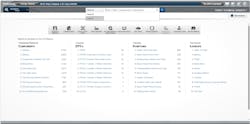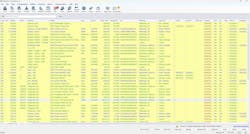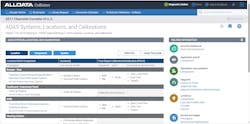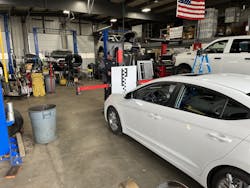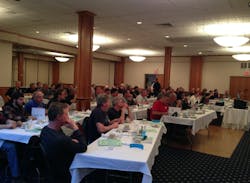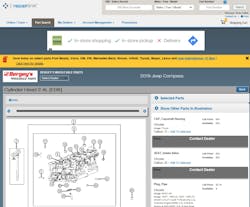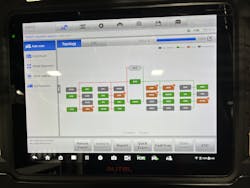Content brought to you by Motor Age. To subscribe, click here.
What You Will Learn:
• Leveraging information from electronic catalogues can efficiently yield an abundance of service information
• Having a multitude of services information sources can fill in gaps and keep you and your shop moving forward without bottlenecks
• Having the "collision" version of a service information package can offer additional features like ADAS service procedures and labor times
When it comes to fixing modern vehicles, I will not accept a vehicle for work if I do not have the proper service information. This system form Mitchell 1 (as well as other sources) has served our shop well for years. (Figure 1). There are certain vehicles out there that are considered low-production vehicles, and they will not typically be included in most aftermarket sources of service information as a result. There are too many factors on today’s vehicles that require you to consult the service information for. From wiring diagrams to torque-to-yield bolt specifications, there is no way to ensure an accurate repair unless you have the service information to consult with. Think of all the things that can go wrong if you don’t have the correct information available to you. The potential for a comeback is staggering when you begin to think about it.
Due to our shop’s reputation for problem solving, we receive many problematic vehicles from other shops for our diagnostic abilities. We are known in the area for getting to the bottom of these so-called problem vehicles.
Don't lean on flowcharts
Our diagnostic process starts with duplicating the problem. We explain to the client that if we cannot duplicate the problem, we are not going to proceed any further. We would otherwise just be guessing at what the problem is. We make a point of making sure the client understands our approach to finding the problem. First, duplicate the problem and then do the necessary research to pinpoint the cause of the problem. Remember, if you are testing a car from a diagnostic flow chart to find a problem, you are guessing. You simply don’t know what the actual problem is at that point. When performing testing on a vehicle, the tests should be to verify the problem, not to find it.
Many years ago, I took a class from Jorge Menchu about color-coding wiring diagrams. The premise was to use specific colors on an electrical circuit that would indicate the voltage level in each part of the circuit: Red, for power all the time, blue for switched power, and so on. This forced me to look harder at the circuits and understand the different voltages throughout the circuits.
It was an amazing class for me and made me look at circuits in a totally different way. As a result, I no longer use diagnostic flow charts; I use wiring diagrams to diagnose vehicles. It saves me time, as I no longer try to interpret the engineer’s thought process. I can look at the wiring diagram and I am able to determine what the voltage should be and test for that.
There are only so many conditions for a circuit to be at. Remember, it is either TTL (transistor-to-transistor logic), your 0-to-5-volt range or CMOS (complementary metal-oxide semiconductor), 0-to-12-volt range. Yes, networks can have different voltage levels, but that information is typically easily found in your information system.
Streamline your process
When we receive a problem vehicle, the very first thing I will do is scan the vehicle. I will typically do this at the end of the day. I will look at the codes and also use Direct-Hit by Identifix to see if there are common failures or bulletins for the specific problem. If there are no common problems, I will simply let it sit in the back of my mind until the next morning. It is not that I am thinking about it, but subconsciously I begin to think it through. I had great success with this and pick up with the vehicle first thing the next morning. I will start with pulling a wiring diagram from Mitchell 1 or ALLDATA and begin to look at common points and what type of testing will be required to identify the problem.
I prefer to use Mitchell 1. Since that is our management system, we can easily access a work-in-progress screen and I can get right into the service information without having to identify the vehicle or copy and paste the VIN (Figure 2). Mitchell 1 has a service information button that you can go to right from the vehicle work order to the service information for the vehicle. With ALLDATA and Direct-Hit, I have to copy and paste the VIN number.
Each of the information systems has its benefits and drawbacks. I am not going to discuss the drawbacks as I feel they are more pet peeves on my part, rather than a negative point of the information system. For Mitchell1 they also have medium and heavy-duty truck information database that we use on a regular basis. For Alldata, I have the collision version which has a great ADAS support menu. Direct-Hit is great for finding common pattern failures. We do not use Direct-Hit as the “be-all, end-all;” we use it to get a potential start to our diagnostic approach and to identify potential failures. Identifix is also a great way to identify bulletins and service procedures related to your search.
Once we have done our research, we will begin our testing process. Again, we will test to verify the problem, not to try and figure out what the problem is. Once we have found the problem, we will take a step back and see if it makes sense and if there could be more than one problem. I cannot think of anything much worse than selling a job and then finding out that it wasn’t the actual problem, then having to call the client to explain the repair did not fix the problem but we need to keep going. I have had this happen, and I took care of the second repair without charging the client. It is all about how you communicate with your client. If there is any doubt in your mind there could be more than one problem, explain to the client this is where the process needs to start.
We do quite a bit of work for local body shops, and because of that we need to know labor times for body repairs. With performing ADAS calibrations, we frequently need to remove bumper covers. With ALLDATA, we have the collision version which provides the labor times for these operations (Figure 3). We also like the ADAS menu within ALLDATA for determining when calibrations are needed. Mitchell 1 has this as well, but we have become accustomed to ALLDATA's ADAS menu.
I have worked with Mitchell 1 since 2000. I am very used to it and that is my go-to information system personally. There are many team members in my shop who have begun using ALLDATA all the time instead of Mitchell 1. I pay for all three information systems, and I am simply glad to see them being used. It is not my place as their manager to tell them which system to use. I do, however, expect them to follow a diagnostic approach.
Many years ago, back in the '90s, I had the privilege of going to GM’s SET electrical class. The SET stood for Specialized Electrical Training. One of the things we were taught in that class was Strategy-Based Diagnosis, a specific path to take when diagnosing a vehicle. I teach that approach to my technicians to this day.
I expect them to test drive the vehicle and duplicate the problem, then check for trouble codes by performing a full vehicle scan. At that point, I expect them to check Identifix. More times than not, this will give us very quick traction on identifying the actual problem. We recently had an older technician who felt he was above this process, and he is no longer with us. He spent way too much time trying to diagnose vehicles. My lead technician walked over more than once and ran the concern on Identifix and found the problem right away.
As part of working with the body shops, we do quite a few ADAS calibrations for them (Figure 4). There are many instances where we need to consult the OEM source for information on trouble codes, measurements, and system operation. Identifix is not as effective on the three-year-old or newer vehicles since they are still under factory warranty, it still has some of the OEM information though.
More and more of today’s vehicles use torque-to-yield bolts. From engine fasteners to suspension fasteners, they are replacing regular fasteners. Remember that they are one-time use bolts. Do you want to send a vehicle out with the potential for the suspension to come loose?
Yes, we are at a point where we need to check factory repair information, even for simple suspension repairs. In the 1960s, you needed to know the equivalent of about two big city phone books to repair all cars. In the early 2000s, it was estimated you needed to know the equivalent of 400 big city phone books to fix all cars. I cannot even begin to estimate where that number is now. My point is to know the theory and know where to find the specific information. We are human and we are not computers with endless storage capability. We as automotive technicians need to understand we are at a point in the industry that we must consult the repair information even for simple repairs to ensure a proper and safe repair.
Information doesn’t cost; it pays
Take the time to learn how to use your specific information system properly and efficiently. They all work a little differently, but the concept is all the same. Our shop has daily access to three different systems, and there are also times I will pay for the manufacturers’ specific information. Typically, I can find the information that I need in the aftermarket information, but there are those times that I cannot. Most of the aftermarket information systems are simply the manufacturers information reprinted, but sometimes the aftermarket does miss things.
Consider attending training for your specific information system or having your system’s rep come out and help train your team (Figure 5). I personally find a group learning experience is better than just a one-on-one type of environment. Understand that there are times it is more cost-effective to pay for the manufacturer's information than to spend the time trying to find it in the aftermarket. Mitchell 1 is great in that you can contact them, and they will try and locate it on their end and then send you the information you requested.
Thinking outside the box
Now let’s look outside of the box. I also consider my electronic cataloging to be an information system (Figure 6). As an example, I use my electronic cataloging for brake drum and rotor specifications. I can get to it quicker through this channel than I can through my actual information systems. Yes, it is personal preference, but it is easier to train a new service writer who is working with a fleet company to find it there rather than through the actual information system. This way, they are working with the management system and not trying to learn an information system on top of it.
I also consider OEC's RepairLink to be a service information system. It has all the VIN attributes for the vehicles. As a result, I do not have to call the dealer to find information ranging from gear ratios to transmission information. It also has the factory parts diagrams that are VIN-specific. If there are multiple choices for the vehicle, RepairLink will narrow it down to your specific vehicle. This is great when it comes to the bigger jobs. My service writers will print out the diagram and give it to my technicians to highlight the needed parts. This method has helped reduce technological layers of complexity.
Our industry technology has gotten to a point where we cannot do our jobs without repair information. Even the scan tool software of today can offer insight about vehicle configuration, such as this topology map (Figure 7). If we continue to just wing it, we may hurt our clients financially and physically. It is our responsibility as professional technicians to train, educate, and learn to teach ourselves to ensure we are fixing cars the correct way. The only way we can ensure that is to read the repair process ahead of the repair. We are at a point in our shop that I would prefer my technicians take the time needed for a correct repair than worry about how long it takes them. Yes, my shop could be more productive, but I value reputation over quantity. As a result of this mindset, we have very few comebacks. Maybe it is time for you to reevaluate your information system and look to expand what you have.

